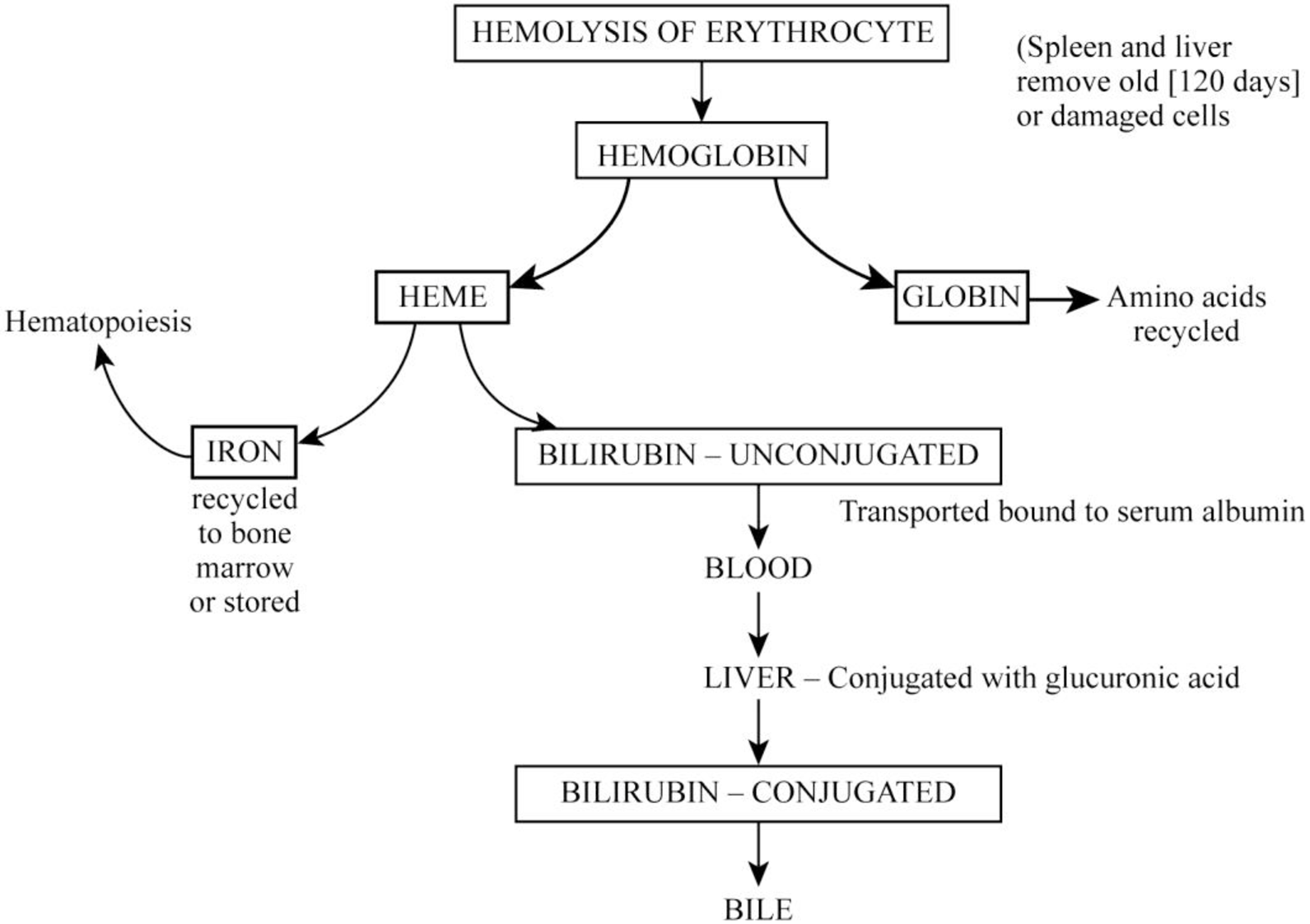
To describe: The life cycle of an erythrocyte, including where it is produced, what is its lifespan and where and how it is destroyed.
Introduction: Erythrocytes, also known as red blood cells (RBCs), form the important constituent of the blood cells. They are typically biconcave disks and are non- nucleated. They consist of a pigment “Hemoglobin”, which gives red color to the blood and plays an important role in transportation of oxygen throughout the body.
Explanation of Solution
The process of production of RBC is called erythropoiesis. Erythropoiesis occurs in the red bone marrow, which includes flat bones that are present in hips, skull, ribs and vertebrae. The primary sources for erythropoiesis are the pluripotent hematopoietic stem cells. The progenitor for the formation of RBC is the megakaryocyte–erythroid progenitor cell. Proerythroblast, basophilic erythroblast, polychromatic erythroblast, and reticulocytes are formed at the initial stages of RBC formation. Finally, the reticulocytes give rise to mature biconcave erythrocytes. The total life span of RBC is about 120 days after which it is degraded in the spleen or liver. After its life span is over, hemoglobin present in RBC is split into its components namely “heme” and “globulin”. The protein part “globin” is degraded into its constituent amino acids and is recycled back. The heme part of hemoglobin can be recycled in two ways. The iron from heme is either recycled back to bone marrow for the process of hematopoiesis or it is used in bilirubin synthesis. In the liver, heme is conjugated with glucoronide so that it becomes more soluble and then it is excreted in the bile.
Pictorial representation: Fig.1 represents the recycling process of erythrocyte.

Fig.1 Recycling process of erythrocyte.
RBCs are produced in red bone marrow, and their life span is nearly 120 days. Destruction or recycling of RBC occurs in the spleen or liver.
Want to see more full solutions like this?
Chapter 10 Solutions
Study Guide for Gould's Pathophysiology for the Health Professions
 Phlebotomy EssentialsNursingISBN:9781451194524Author:Ruth McCall, Cathee M. Tankersley MT(ASCP)Publisher:JONES+BARTLETT PUBLISHERS, INC.
Phlebotomy EssentialsNursingISBN:9781451194524Author:Ruth McCall, Cathee M. Tankersley MT(ASCP)Publisher:JONES+BARTLETT PUBLISHERS, INC. Gould's Pathophysiology for the Health Profession...NursingISBN:9780323414425Author:Robert J Hubert BSPublisher:Saunders
Gould's Pathophysiology for the Health Profession...NursingISBN:9780323414425Author:Robert J Hubert BSPublisher:Saunders Fundamentals Of NursingNursingISBN:9781496362179Author:Taylor, Carol (carol R.), LYNN, Pamela (pamela Barbara), Bartlett, Jennifer L.Publisher:Wolters Kluwer,
Fundamentals Of NursingNursingISBN:9781496362179Author:Taylor, Carol (carol R.), LYNN, Pamela (pamela Barbara), Bartlett, Jennifer L.Publisher:Wolters Kluwer, Fundamentals of Nursing, 9eNursingISBN:9780323327404Author:Patricia A. Potter RN MSN PhD FAAN, Anne Griffin Perry RN EdD FAAN, Patricia Stockert RN BSN MS PhD, Amy Hall RN BSN MS PhD CNEPublisher:Elsevier Science
Fundamentals of Nursing, 9eNursingISBN:9780323327404Author:Patricia A. Potter RN MSN PhD FAAN, Anne Griffin Perry RN EdD FAAN, Patricia Stockert RN BSN MS PhD, Amy Hall RN BSN MS PhD CNEPublisher:Elsevier Science Study Guide for Gould's Pathophysiology for the H...NursingISBN:9780323414142Author:Hubert BS, Robert J; VanMeter PhD, Karin C.Publisher:Saunders
Study Guide for Gould's Pathophysiology for the H...NursingISBN:9780323414142Author:Hubert BS, Robert J; VanMeter PhD, Karin C.Publisher:Saunders Issues and Ethics in the Helping Professions (Min...NursingISBN:9781337406291Author:Gerald Corey, Marianne Schneider Corey, Cindy CoreyPublisher:Cengage Learning
Issues and Ethics in the Helping Professions (Min...NursingISBN:9781337406291Author:Gerald Corey, Marianne Schneider Corey, Cindy CoreyPublisher:Cengage Learning





